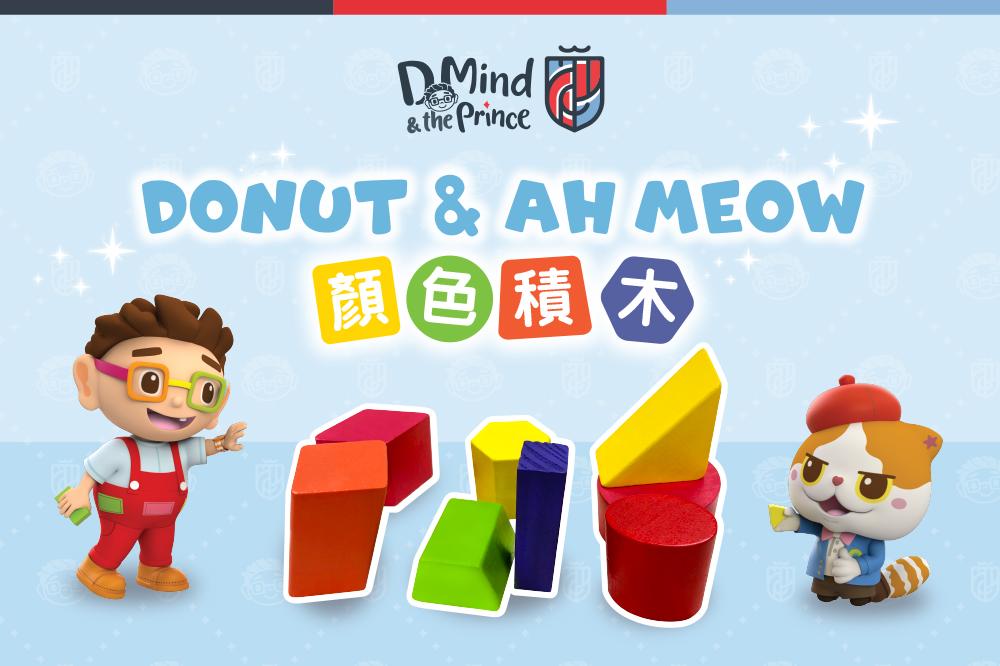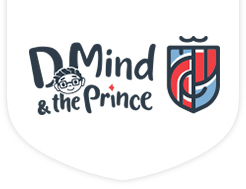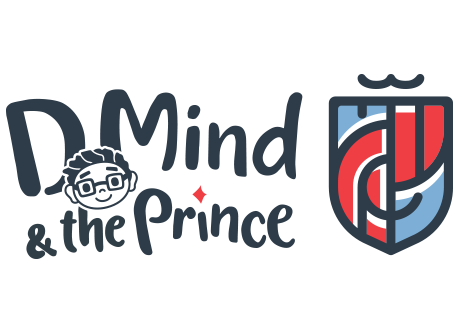Donut & Ah Meow 顏色積木遊戲

“Donut & Ah Meow 顏色積木” 套裝包含不同形狀的立體積木,你知道這些立體的名稱和特性嗎?玩積木遊戲之前,讓我們跟Donut一起認識不同的立體圖形吧﹗
| 積木 | 名稱 | 特性 |
|
圓柱 cylinder |
圓柱有兩個圓形的面,它的側面是曲的。把曲面向下放,積木會滾動哦﹗ |
|
橢圓柱 elliptic cylinder |
橢圓柱有兩個橢圓形的面,它的側面也是曲的。把曲面向下放,積木也會滾動哦﹗ |
|
四角柱 quadrilateral prism |
四角柱的底面是四邊形,這個四邊形是菱形呢﹗ |
|
長方體 cuboid |
長方體像一條長條,它的底面是正方形,側面是長方形。 |
|
斜四角柱 oblique quadrilateral prism |
斜四角柱像一個傾斜了的四角柱,它很容易倒下哦﹗ | |
|
三角柱 triangular prism |
三角柱的底面都是三角形。 |
|
六角柱 hexagonal prism |
六角柱的底面則是六邊形,這個底面有六條邊。 |
你能觀察一下每塊積木,說說它們更多的特性嗎?
認識好每個立體,便可以一起砌積木、玩遊戲啦﹗
遊戲1:包剪揼層層疊 對象:K1-K3 小孩,2-3 人
提升技巧/能力:認識不同立體的特性,專注力,平衡力
遊戲目標:
遊戲主要讓孩子認識各種立體的特性,並透過遊戲訓練孩子專注力和手指頭小肌肉操控。遊戲過程中亦可讓年紀較大的孩子思考如何放置積木來影響積木塔的穩定性,例如把面積較大的面作為底部來堆疊可增加穩定性,或把曲面作為底部會增加下一塊積木倒下的機會。建議玩遊戲前先跟孩子認識各種立體。
玩法:
- 把其中一塊積木先放在桌中央。
- 2-3人猜包剪揼,輸家任意取一塊積木疊在桌中央的積木上,疊高時不能弄跌其他積木。
- 重覆猜包剪揼並疊高積木,如疊高時弄倒積木塔便輸。
- 成功堆疊所有積木並不倒的玩家為勝。
遊戲2:幻想工程師 對象:K1-K3 小孩,1 人 (進階版:2 人或以上)
提升技巧/能力:想像力,溝通技巧,平衡力
遊戲目標:
遊戲讓孩子化身成幻想工程師,充份運用想像力,用積木建設不同的物件。完成建設後,孩子需解說物件的特徵,從而訓練孩子的說話能力和邏輯思考。進階版的多人遊戲亦可促進孩子間的溝通,從其他孩子猜想的物件亦可讓孩子思考如何提升所堆出積木跟物件的相似度。
玩法:
- 用各種積木自由創作砌出物件。
- 砌好後可以告訴老師/照顧者該物件的特徵,並說說怎樣看出堆出的積木是該物件。
- 進階版:2人或以上玩,可以1人負責堆積木,其他人輪流猜猜所砌出的是什麼物件,正確猜得出該物件的玩家為勝。
★ ★ ★ ★ ★
“Donut & Ah Meow building blocks set” includes blocks in different colours and shapes. Do you know their names and characteristics? Let’s learn the different shapes with Donut!
| Blocks | Name | Characteristics |
|
cylinder |
A cylinder has two circular faces and a curved lateral surface. If we face the curved surface down, the block will roll. |
|
elliptic cylinder |
An elliptic cylinder has two oval faces and a curved lateral surface. If we face the curved surface down, the block will roll too. |
|
quadrilateral prism |
A quadrilateral prism has a quadrilateral base. This base is a rhombus. |
|
cuboid |
Cuboid looks like a long stick. It base is a square. It has rectangular lateral surfaces. |
|
oblique quadrilateral prism |
An oblique quadrilateral prism looks like an inclined quadrilateral prism. It can easily fall! | |
|
triangular prism |
The base of a triangular prism is triangle. |
|
hexagonal prism |
The base of a hexagonal prism is a hexagon. It has six edges. |
Observe each block carefully. Can you tell their differences and characteristics?
Learn about the shapes and play the following games together!
Game 1: Tower builders Target: K1-K3 children, 2-3 people
Skills/abilities trained: observation of the characteristics of different shapes, concentration, balance
Objectives:
This game allows children to understand the characteristics of different shapes. It also trains children's concentration and builds their fine motor skills. More advanced players may explore how stacking a certain block may affect the stability of the block tower. For example, placing a block with a larger surface at the bottom makes the block tower more stable; or stacking a block with a curved surface will make the next block fall easily. Players are recommended to learn about the shapes before playing this game.
Instructions:
- Place a block at the centre of the table to start the game.
- Players play rock, paper, scissors. The loser chooses a block and stack it on the first block to make a block tower. Players cannot touch the other blocks during stacking.
- Repeat the above process. Keep stacking until the block tower falls over.
- The first player to finish stacking all the blocks wins.
Game 2: Creative Engineer Target: K1-K3 children, 1 person (Advanced version: 2 or more people)
Skills/abilities trained: imagination, communication, balance
Objectives:
This game encourages children to become creative engineers by using their imagination to build different objects with the building blocks. After building an object, parents can encourage children to talk about the features and characteristics of the object in order to enhance children’s communication skills and logical thinking. When the game is played as a multiplayer guessing game, children can also learn to review and reflect on ways to improve their design to make the stacked blocks more similar to the actual object.
Instructions:
- Create and build objects using different building blocks.
- After building an object, the player can share with the parent/caregiver the characteristics of the object, and talk about how the stacked blocks and the actual object are similar.
- Advanced version: For 2 or more players. 1 player builds an object with the blocks. The other players will take turns to guess what the object is. The player who guessed the object correctly wins.



 返回列表
返回列表
